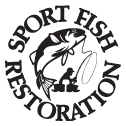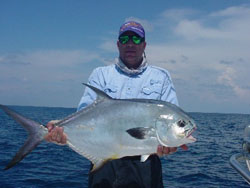CONTACT US:
Florida Fish and Wildlife
Conservation Commission
Fish and Wildlife
Research Institute
100 Eighth Avenue SE
St. Petersburg, Florida 33701
727-896-8626
|
|
|
City of Jacksonville
Parks and Recreation
214 N. Hogan Street
Third Floor
Jacksonville, Florida
32202
904-630-2489
|
|
|


|
|
This project was funded in part by a grant awarded by the and .
|

|
|
Additional funding for this project was obtained through the .
|
|
|
 |
Increasingly, anglers are practicing “catch-and-release” to do their part to preserve marine fisheries while they enjoy their outdoor fishing experiences. This information offers tips on how you can properly handle and release saltwater fish.
Know Before you Go
- Make sure you can identify the fish you are targeting.
- Always know (or have access to) the current regulations for the fish you target. This minimizes handling time when determining whether or not you can keep the fish you caught.
- Use tackle heavy enough to bring the fish in quickly, and avoid using multi-hook rigs or lures.
- If you have a treble hook, you can remove some of the hooks and flatten the barbs.
- Make sure you have all the proper tools and gear on your vessel before heading out for the day.
Handling Fish
- Handle fish as little as possible and only with wet hands.
- Match tackle to the targeted fish to land it quickly and minimize stress on the fish.
- Never hold a fish by its jaw, gills or eyes. Hold the fish horizontally and support its weight with both hands.
- Release the fish as quickly as possible and if possible keep the fish in the water at all times.
Removing the Hook
- Using a dehooking tool is safer for the fish and for you.
- Cut the leader as close to the hook as possible if it cannot be quickly removed.
- When using natural bait (live or dead) use circle hooks to reduce internal harm and decrease dehooking time.
The Release
- Gently place the fish head first in the water, supporting its body until it swims away.
- A fish that has been stressed by the fight or handling should be revived by moving it forward in the water to promote water flow over the gills.
- If a released fish does not swim away, recover it and try again.
Releasing a fish safely and free of harm is key to helping it survive.
Additional information about catch-and-release is available from Florida Sea Grant.
|
Taking Photos of Your Catch
Florida is the “Fishing Capital of the World” due to great resources and responsible management, and we want to keep it that way. Promoting Florida fishing and boating includes an obligation to portray the fun, excitement and camaraderie in a positive fashion that reflects safe and sustainable use of Florida’s natural resources. As a consequence, some photographic tips and guidelines are provided, and we encourage all of our partners to use them to the greatest extent possible.
|

A fisherman holding a permit correctly |
- When possible leave fish in the water for the photo, if they are going to be released--and definitely, if they are illegal to harvest. A good angle is with the fish held at the surface and the photo taken from over the angler’s shoulder. It gives size and perspective to the fish without ever taking it out of the water.
- Fish that are illegal to harvest, due to creel or size limits, should be shown in the water—for instance, undersized sailfish jumping or a goliath grouper alongside the boat about to be released.
- Tarpon that are out of the water should preferably have a “legally harvested” tag showing.
- The proper way is to hold the fish horizontally with its weight distributed as evenly as possible. Lip grips can be damaging if the jaw is hyper-extended or the fish is too heavy and is suspended only by the jaw. However, holding and supporting the fish horizontally with a thumb (depending on the species be careful of sharp teeth) or lip grip in the mouth and using the other hand to help support and control the fish can keep it from thrashing around or getting loose.
Additional tips for taking photos of your catch with guidelines for handling can be found here.
|
If you have any questions, comments, or suggestions about this Web site, please e-mail us at Boating_Guides@MyFWC.com.
Would you like to receive notices of changes to this Web site and the Boating and Angling Guide to Nassau and Duval Counties? If so, please e-mail us and include SUBSCRIBE-DUVAL in the subject line.
|

























